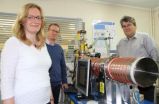(Press-News.org) Barcelona, Spain – Monday 1 September 2014: Daily fruit consumption cuts the risk of cardiovascular disease (CVD) by up to 40%, according to research presented at ESC Congress today by Dr Huaidong Du from Oxford, UK. The findings from the seven year follow-up study of nearly 0.5 million people in the China Kadoorie Biobank found that the more fruit people ate, the more their risk of CVD declined.
Dr Du said: "CVD, including ischaemic heart disease (IHD) and stroke, is the leading cause of death worldwide. Improving diet and lifestyle is critical for CVD risk reduction in the general population but the large majority of this evidence has come from western countries and hardly any from China."
She added: "China has a different pattern of CVD, with stroke as the main cause compared to western countries where IHD is more prevalent. Previous studies have combined ischaemic and haemorrhagic stroke probably due to the limited number of stroke cases in their datasets. Given their different physiology and risk factors, we have conducted the first large prospective study on the association of fruit with subtypes of stroke in Chinese adults from both rural and urban areas."
The current study included 451 681 participants with no history of CVD and not on anti-hypertensive treatment at baseline from the China Kadoorie Biobank(1) conducted in 10 different areas of China, 5 rural and 5 urban. Habitual consumption of fruit was recorded at baseline according to five categories: never, monthly, 1-3 days per week, 4-6 days per week, daily.
Over the seven year follow up period there were 19 300 cases of IHD and 19 689 strokes (14 688 ischaemic and 3562 haemorrhagic). Some 18% of participants consumed fruit daily and 6.3% never consumed fruit. The average amount of fruit eaten by the daily consumers was 1.5 portions (~150g) (2).
The researchers found that compared to people who never ate fruit, those who ate fruit daily cut their CVD risks by 25-40% (around 15% for IHD, around 25% for ischaemic stroke and 40% for haemorrhagic stroke). There was a dose response relationship between the frequency of fruit consumption and the risk of CVD (see figure).
Dr Du said: "Our data clearly shows that eating fresh fruit can reduce the risk of cardiovascular disease, including ischaemic heart disease and stroke (particularly haemorrhagic stroke). And not only that, the more fruit you eat the more your CVD risk goes down. It does suggest that eating more fruit is beneficial compared to less or no fruit."
The researchers also found that people who consumed fruit more often had significantly lower blood pressure (BP). Eating fruit daily was associated with 3.4/4.1 mmHg lower systolic/diastolic BP compared to those who never ate fruit. Dr Du said: "Our data shows that eating fresh fruit was associated with lower baseline BP. We also found that the beneficial effect of fruit on the risk of CVD was independent of its impact on baseline BP."
In a separate analysis, the researchers examined the association of fruit consumption with total mortality and CV mortality in more than 61 000 patients from the China Kadoorie Biobank who had CVD or hypertension at baseline. They found that compared to those who never ate fruit, daily consumers of fruit cut their overall risk of death by 32%. They also reduced their risks of dying from IHD by 27% and from stroke by around 40%.
Professor Zhengming Chen, the principal investigator of the China Kadoorie Biobank, said: "Patients with CVD and hypertension should also be encouraged to consume more fresh fruit. Many western populations have experienced a rapid decrease in CVD mortality during the past several decades, especially stroke mortality since the early 1950s, for reasons that are not yet fully explained. Improved access to fresh fruit may well have contributed importantly to that decline."
The researchers concluded: "Our results show the benefit of eating fruit in the healthy general population and in patients with CVD and hypertension. Fruit consumption is an effective way to cut CVD risk and should not only be regarded as 'might be useful'. Policies are needed to promote the availability, affordability and acceptability of fresh fruit through educational and regulatory measures."
INFORMATION:
References
(1) The China Kadoorie Biobank is a prospective cohort study established jointly by the University of Oxford's Clinical Trial Service Unit and Epidemiological Studies Unit and the Chinese Academy of Medical Sciences. The baseline survey took place during 2004 and 2008 involving 0.5 million people in 10 regions across China including 5 urban and 5 rural. For more information visit here. http://www.ckbiobank.org/site/
(2) The China Kadoorie Biobank conducts a resurvey every 4 or 5 years among about 5% of randomly selected participants who are still alive. A resurvey is ongoing and will be completed by the end of August/beginning of September. Initial data show that the average amount of fruit eaten by the daily consumption group is 1.5 portions (150g).
Notes to editors
Authors: ESC Press Office
Tel: +34 670 521 210 (ESC Spokesperson Coordinator – Tanya Kenny)
Email: press@escardio.org
About the European Society of Cardiology
The European Society of Cardiology (ESC) represents more than 80 000 cardiology professionals across Europe and the Mediterranean. Its mission is to reduce the burden of cardiovascular disease in Europe.
About ESC Congress 2014
ESC Congress is currently the world's largest international congress in cardiovascular medicine. ESC Congress 2014 takes place 30 August to 3 September at the Fira Gran Via congress centre in Barcelona, Spain.
This press release accompanies a presentation at the ESC Congress 2014. The press release has been written by the investigator and edited by the ESC and does not necessarily reflect the opinion of the European Society of Cardiology.
EMBARGO: Monday 1 September 2014 at 04:30pm CEST
SUBMITTED TO A SCIENTIFIC JOURNAL: n/a
SPONSOR: n/a
REFERS TO SESSION: State of the Art - The global threats of smoking and poor diet: meeting the challenges
http://spo.escardio.org/SessionDetails.aspx?eevtid=69&sessId=13830
More information available on ESC Congress 365 after the scientific session: slides and webcast when available (http://congress365.escardio.org/)
Fruit consumption cuts CVD risk by up to 40 percent
2014-09-01
ELSE PRESS RELEASES FROM THIS DATE:
Permanent AF doubles risk of stroke compared to paroxysmal AF
2014-09-01
Barcelona, Spain – Monday 1 September 2014: Permanent atrial fibrillation (AF) doubles the risk of stroke compared to paroxysmal AF, according to research in more than 6 000 patients presented at ESC Congress today by Dr Thomas Vanassche from Belgium. The findings suggest that a simple clinical assessment of the type of AF can help doctors to better estimate stroke risk.
Ischaemic stroke is the second cause of death in the EU, accounting for over a million deaths and many more disabled patients each year. Annual direct health care costs amount to more than €20 billion. ...
A nucleotide change could initiate fragile X syndrome
2014-09-01
Researchers reveal how the alteration of a single nucleotide—the basic building block of DNA—could initiate fragile X syndrome, the most common inherited form of intellectual disability. The study appears in The Journal of Cell Biology.
Fragile X syndrome is caused by a defect in a gene on the X chromosome called fragile X mental retardation 1 (FMR1). Around 1 in 230 women and 1 in 360 men carry a so-called premutation, in which a series of DNA repeats at one end of the FMR1 gene is slightly longer than normal. These repeats are prone to even further expansion when ...
Scientists call for investigation of mysterious cloud-like collections in cells
2014-09-01
WASHINGTON — About 50 years ago, electron microscopy revealed the presence of tiny blob-like structures that form inside cells, move around and disappear. But scientists still don't know what they do — even though these shifting cloud-like collections of proteins are believed to be crucial to the life of a cell, and therefore could offer a new approach to disease treatment.
In the Journal of Cell Biology, two researchers are issuing a call to investigators from various backgrounds, from biophysics to cell biology, to focus their attention on the role of these formations— ...
Zooming in for a safe flight
2014-09-01
As nocturnal animals, bats are perfectly adapted to a life without light. They emit echolocation sounds and use the delay between the reflected echoes to measure distance to obstacles or prey. In their brains, they have a spatial map representing different echo delays. A study carried out by researchers at Technische Universität München (TUM) has shown for the first time that this map dynamically adapts to external factors.
Closer objects appear larger
When a bat flies in too close to an object, the number of activated neurons in its brain increases. As a result, ...
Week-long meeting on naming algae, fungi, and plants recorded for posterity
2014-09-01
The week-long discussions and decisions of the Nomenclature Section of the XVIII International Botanical Congress took place in Melbourne, Australia in July 2011. This meeting is held every six years and it is where the world's premier experts on the rules for naming algae, fungi and plants get together to debate and update the rule book for naming the organisms they study. This is the primary product of the meeting, the International Code of Nomenclature for algae, fungi, and plants, which was published in 2012. The other important product is the official report for the ...
Scientists get set for simulated nuclear inspection
2014-09-01
Some 40 scientists and technicians from around the world will descend on Jordan in November to take part in a simulated on-site inspection of a suspected nuclear test site on the banks of the Dead Sea.
Playing the part of inspectors, the experts will have access to a wide range of sensor technologies to look for signs of whether a nuclear explosion has taken place. At the same time, other role-players representing the state under inspection will try to put them off their scent.
The aim of this elaborate exercise, as science writer Edwin Cartlidge explains in this month's ...
Invisible blood in urine may indicate bladder cancer
2014-09-01
New research which finds that invisible blood in urine may be an early warning sign of bladder cancer is likely to shape guidelines for clinicians.
Scientists at the University of Exeter Medical School found that one in 60 people over the age of 60 who had invisible blood in their urine (identified by their GP testing their urine) transpired to have bladder cancer. The figure was around half those who had visible blood in their urine – the best known indicator of bladder cancer. However, it was still higher than figures for other potential symptoms of bladder cancer ...
Sugar substance 'kills' good HDL cholesterol, new research finds
2014-09-01
Scientists at the University of Warwick have discovered that 'good' cholesterol is turned 'bad' by a sugar-derived substance.
The substance, methylglyoxal - MG, was found to damage 'good' HDL cholesterol, which removes excess levels of bad cholesterol from the body.
Low levels of HDL, High Density Lipoprotein, are closely linked to heart disease, with increased levels of MG being common in the elderly and those with diabetes or kidney problems.
Supported by funding from the British Heart Foundation (BHF) and published in Nutrition and Diabetes, the researchers ...
New tuberculosis blood test in children is reliable and highly specific
2014-09-01
A new blood test provides a fast and accurate tool to diagnose tuberculosis in children, a new proof-of-concept study shows. The newly developed test (TAM-TB assay) is the first reliable immunodiagnostic assay to detect active tuberculosis in children. The test features excellent specificity, a similar sensitivity as culture tests in combination with speed of a blood test. The promising findings are a major advance for the diagnosis of tuberculosis in children, particularly in tuberculosis-endemic regions.
The study has been published on Sept 1st, 2014 in Lancet Infectious ...
Scientists develop 'electronic nose' for rapid detection of C. diff infection
2014-09-01
A fast-sensitive "electronic-nose" for sniffing the highly infectious bacteria C. diff, that causes diarrhoea, temperature and stomach cramps, has been developed by a team at the University of Leicester.
Using a mass spectrometer, the research team has demonstrated that it is possible to identify the unique 'smell' of C. diff which would lead to rapid diagnosis of the condition.
What is more, the Leicester team say it could be possible to identify different strains of the disease simply from their smell – a chemical fingerprint - helping medics to target the particular ...






